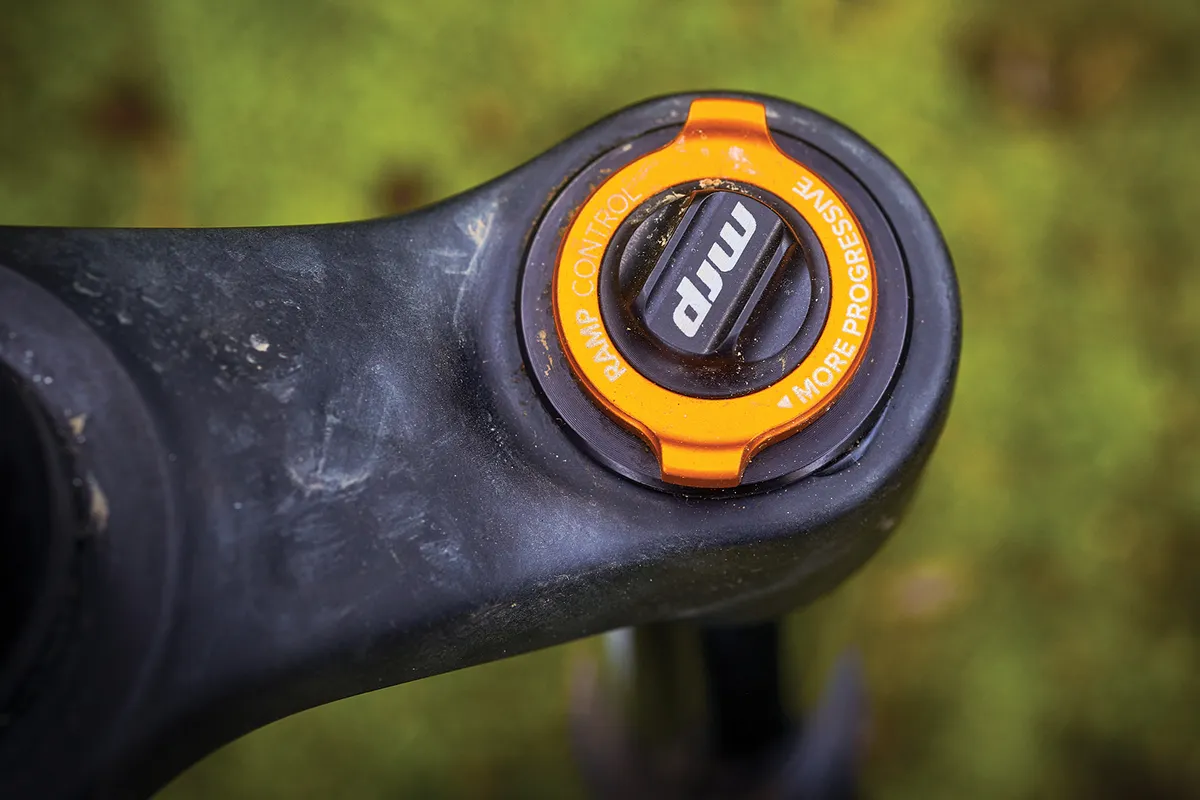Designed for trail riding and enduro racing, MRP's Ribbon Air is the lightest of the ten enduro forks that were on test at 1,919g in 29in. It’s also got a great USP in the form of its Ramp Control dial, which affects how difficult the fork is to bottom out and can be adjusted at the trail side.
The fork also features a forward-facing arch, which reduces the amount of mud that collects there.
Small valves allow excess air pressure in the lowers to be bled off to compensate for a big change in altitude that could otherwise make the fork firmer at the start of the travel (I rarely find this an issue with forks that lack this feature, however).
The damper offers compression and rebound adjustment, while the air spring is not self-equalising, so it requires the positive and negative chambers to be pressurised independently via valves at the top and bottom of the fork.
- This fork was tested as part of a group test including ten of the best enduro forks. All forks were tested back-to-back on the same tracks, keeping all other variables as consistent as possible to ensure our findings are as reliable and accurate as they can be.
MRP Ribbon Air setup
Following MRP’s recommendation, I started with the negative spring at 5psi more pressure than the positive, to maximise sensitivity at the start of the travel. Any more than this and the fork sucks down into its travel when unloaded, thereby reducing the travel on offer.
At first, I adjusted the air pressure to achieve 20 per cent sag, then used the Ramp Control dial so I could achieve 135mm of travel when bouncing on the fork in the car park. This was to give a baseline setup that matched the other forks on test.

MRP Ribbon Air performance
While the Ramp Control dial is conceptually appealing, because it allows progression to be adjusted on the trailside, it can’t match the predictable support offered by volume spacers.
After much trial and error, I couldn’t find any setting that matched the sensitivity of its rivals while maintaining enough support.
MRP’s Ramp Control spring works by releasing air into a separate chamber through an adjustable blow-off valve when the pressure becomes high enough. The further clockwise the dial is turned, the more pressure is needed to allow air to pass through the valve and so the more progressive the fork feels.
Unusually, this air-spring design is speed sensitive, a little bit like a damper. When the fork compresses rapidly, the air in the main chamber has less time to pass through the valve, and so the spring is more progressive. Whereas if the fork is compressed in a slower, sustained way, the air has more time to bleed through the valve, so the fork feels more linear.
In practice, that means it lacks support during prolonged compressions, such as corners or sustained braking, yet feels harsh over sudden impacts. Set the Ramp Control dial to open and the fork lacks mid-stroke support even when setup with minimal sag, causing it to dive hard under braking. But wind it on one click at a time and the fork becomes harsh over bigger impacts before it provides meaningful extra support.
Unnervingly, the Ribbon Air seems to take longer to recover from deep in the stroke than other forks too, even with the rebound set fast, and the chassis flexes noticeably when pushed hard through big holes. This caused me to lose control and swerve after a bumpy step-down landing twice in succession, where I had no such issues with the nine other forks tested. On the third attempt I avoided the step-down.
At the same time, the MRP was uncomfortable and jarring over fast, chattery trails, even with the compression damping set fully open.
How does it compare to its key rivals?
The MRP Air doesn’t compare favourably to any of the other forks tested. Only the over-damped Öhlins RXF 36 EVO was similarly uncomfortable over high-frequency bumps, but it was far more supportive and predictable when pushed hard than the flimsier-feeling MRP.
We tested the coil version of the MRP Ribbon in a previous group test, where it ranked mid-pack, but we still thought the damping was a little wooden.
Overall, the MRP Ribbon Air’s unsupportive, uncomfortable and unpredictable feel had me riding far more defensively than its rivals.
This video shows how we tested the forks and how they compare.
Product
| Brand | Mrp |
| Price | £850.00, $990.00 |
| Weight | 1919g |
Features
| Spring type | air |
| Wheel size | 29in_700c |
| Travel | 160.0000 |
| Travel | MILLIMETER |
| Features | Travel Options: 29in - 120, 130, 140, 150, 160mm Travel Options: 27.5in 140, 150, 160, 170mm Crown to axel length: 574mm (29in x 160mm) |
